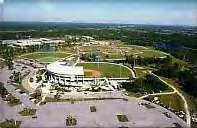Uptown at RiversEdge Should First be Green Area for Community Use
Second Advisory Group Raises Questions, Pushes Economic Development, Jobs
December 28, 2003
By: Dave Rogers

St. Lucie West is a development by a member of the Urban Land Institute, a non-profit advisory group whose members have developed projects all over the nation, including several in the Midwest.
Expansion of the site for Uptown at RiversEdge was proposed by the Urban Land Institute advisors in their recent report to a special city finance and policy committee meeting.
ULI planners led by James L. Zboril of St. Lucie West, Florida, recommended the city select a "realistic" comparable city to use as a model, one with similar characteristics.
Setting aside the myriad of questions, fears and doubts raised by the advisors, several pertinent recommendations did arisefrom the more than two hour session.
The "essence of Bay City" should be promoted, ULI suggested, commenting: "people like this community and that's not always the case in other cities; attach that to your economic development message, link community assets. You have a lot of good projects, the Riverwalk, downtown, marinas, etc."
The project should include more than just the 48 acre Industrial Brownhoist property on Water Street, it should link City Hall, vacant property owned by the Great Lakes Foundation, the Bay Area Family Y and the F. P. Horak printing company, as well as links to the Riverwalk and Veterans Memorial Bridge to the north.
Colleges, universities or technical schools might become partners and locate on the site, providing seed programs for high end R&D jobs. Tourism is not completely out as a driving economic force, the ULI planners suggested, pointing out that the Delta College Planetarium attracts about 40,000 visitors a year.
The site should first be cleaned up and converted to green space for festivals, a farmer's market, art fairs, passive recreation and other community activities.
Such first phase cleanup and development will prepare the site for future development with more impact, said Zaboril, commenting: "Eliminate the blight people see coming over the bridge."
ULI advisors raised more questions than they provided answers and referred many of the problem areas to the consultants, the Weitzman Group, of New York City. Some of those issues raised are outside the scope of the Weitzman study, said Thomas Justin, Weitzman president, who was on hand at the ULI report meeting. These issues include determining marketability and financial (cost/benefit) analysis.
Keeping most of the old buildings on the site is probably not financially feasible, despite community wishes stated in the visioning sessions, according to the consultants.
Drawbacks of the site involving environmental and physical barriers and costs of development were big negatives to ULI planners.
Consultants revealed that a recent study by Brogan and Partners of 800 Michigan small business respondents found little knowledge of the Bay City, Saginaw, Midland area and a reluctance to move business facilities here because of a strong union presence.
City officials and planners will have to evaluate a host of other recommendations and comments about general economic development and decide early next year whether to financially support a countywide ED effort. Consultants urged the city to hire a corporate recruiter to do nothing but contact companies with potential to move here. That strategy has been discussed over the past few years in talks among county officials and the private sector led by County Executive Tom Hickner and Chemical Bank Chief Dom Monastiere.
ULI members urged the city to "be a player" in regional economic development but to pursuethe city's particular development agenda alone with a "strategic approach." No solid recommendation was made about the city's proposed participation in a countywide public/private economic development coalition.
ULI is a not-for-profit professional organization whose membership includes developers, planners, architects, bankers, etc. ULI is not a developer or consultant organization, according to ULI spokesperson Sherida E. Paulsen.
ULI—the Urban Land Institute is a 501(c) (3) nonprofit research and education organization supported by its members.
Founded in 1936, the institute now has more than 18,000 members worldwide representing the entire spectrum of land use and real estate development disciplines, working in private enterprise and public service.
As the preeminent, multidisciplinary real estate forum, ULI facilitates the open exchange of ideas, information and experience among local, national and international industry leaders and policy makers dedicated to creating better places.
The mission of the Urban Land Institute is to provide responsible leadershipin the use of land to enhance the total environment.